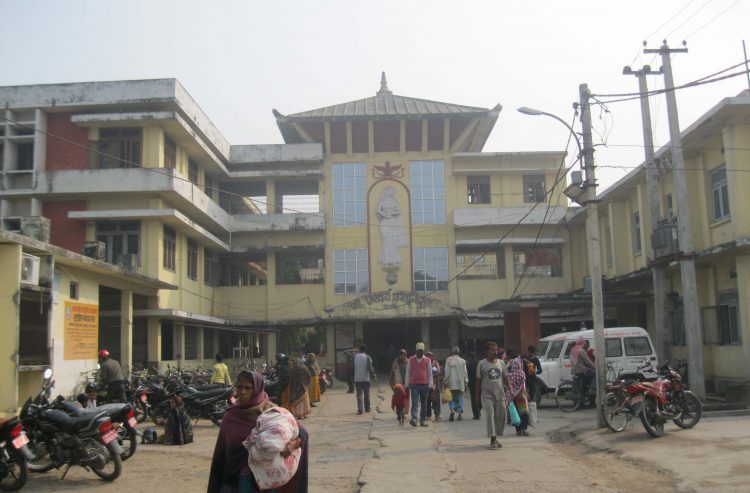Who should be credited for introducing health insurance program in Nepal?
Sujit Mainali / August 24, 2018

Shree Panch Aishwarya Maternity Hospital, Birgunj pictured in December 2015. Photo: Sujit Mainali
In the “Tamasoma Jyotirgamaya” program aired on Kathmandu-based AP1 television on August 20, Prime Minister KP Oli claimed that his party, the then CPN-UML, had introduced the health insurance program in Nepal.
When the interviewer told him that the health insurance program was introduced when Nepali Congress leader Gagan Thapa was the health minister, Prime Minister Oli replied: “Which government did you say launched [the health insurance program]?”
After the interviewer insisted that the health insurance program was introduced in some places as pilot project when Thapa was the health minister, Prime Minster Oli questioned again, “Are you sure about your claim?”
“How can I say something without being sure?” replied the interviewer.
The prime minister then said, “That’s wrong …we introduced the program when Khagaraj Adhikari was the health minister.”
South Asia Check has studied the history of the health insurance program in Nepal and the progress made so far.
CPN-UML’s Khagaraj Adhikari was health minister of the government led by Prime Minister Sushil Koirala between February 2014 and October 2015. According to the annual report of the fiscal year 2015/16 published by the government’s Social Health Security Development Committee, Koirala-led government issued the Social Health Security Development Committee (Formation) Order 2014. The order paved the way for implementing the health insurance program.
In accordance with the plan, health insurance program was launched in Kailali district on April 7, 2016 and in Baglung and Ilam on June 29, 2016. Ramjanam Chaduary of Madhesi People’s Rights Forum-Democratic was health minister and KP Oli was the prime minister when the insurance program was launched in the three districts.
As per the very plan, the health insurance program was to be expanded to 22 more districts in the fiscal year 2016/17. In accordance with the plan, then finance minister in the KP Oli-led government, Bishnu Paudel, allocated Rs 2.5 billion to run program in the 25 districts [see point number 240 of his 2016/17 budget speech].
In the meantime, KP Oli resigned and the new government was formed under the leadership of then CPN (Maoist Center) Chairman Pushpa Kamal Dahal. Gagan Thapa became health minister in the new government.
Later the Dahal-led government was replaced by a new government led by Nepali Congress President Sher Bahadur Deuba. This time, then CPN (Maoist Center) leader Giriraj Mani Pokhrel became health minister. When Pokhrel was the health minister, the parliament endorsed the Health Insurance Act, 2017, which states that “all Nepali citizens must participate in the health insurance program” [see point number 3(1)].
CPN-UML and CPN (Maoist Center) later unified to become the Nepal Communist Party (NCP).
Although important decisions were made to advance the health insurance program when Khagaraj Adhikari was health minister, health insurance program was not a new idea in Nepal as various governments had discussed and implemented the program in small scale. In the report titled “Review of Community-based Health Insurance Initiatives in Nepal“, the then director of the Department of Health Service Ananda Kumar Shrestha has mentioned that “at the implementation level, the Ministry of Health and Population has been piloting community-based health insurance schemes since 2003/04”. According to the same report, the prime minister’s office had issued a directive to the Ministry of Health and Population in January 2012 to formulate and implement a “health insurance policy for all Nepalis”. When the directive was issued, the then Maoist leader Baburam Bhattarai [coordinator of the present-day Naya Shakti Nepal] was the prime minister.
This material is copyrighted but may be used for any purpose by giving due credit to southasiacheck.org.
Comments
Latest Stories
- In Public Interest Covid-19 cases are low, but that’s not an excuse to avoid vaccination
- In Public Interest What is BF.7, the sub-variant that has the world by its grip?
- In Public Interest Threat of a new Covid-19 wave looms large amid vaccine shortage in Nepal
- In Public Interest As cases decline, Covid-19 test centres in Kathmandu are desolate lot
- In Public Interest Dengue test fee disparity has patients wondering if they’re being cheated
- In Public Interest As dengue rages on, confusion galore about what it is and what its symptoms are. Here’s what you need to know
In Public Interest
 Covid-19 cases are low, but that’s not an excuse to avoid vaccination
The Pfizer-BioNTech bivalent vaccines authorised by the Nepal Government provide better protection a...
Read More
Covid-19 cases are low, but that’s not an excuse to avoid vaccination
The Pfizer-BioNTech bivalent vaccines authorised by the Nepal Government provide better protection a...
Read More
- What is BF.7, the sub-variant that has the world by its grip?
- Threat of a new Covid-19 wave looms large amid vaccine shortage in Nepal
- As cases decline, Covid-19 test centres in Kathmandu are desolate lot
- Dengue test fee disparity has patients wondering if they’re being cheated
- As dengue rages on, confusion galore about what it is and what its symptoms are. Here’s what you need to know